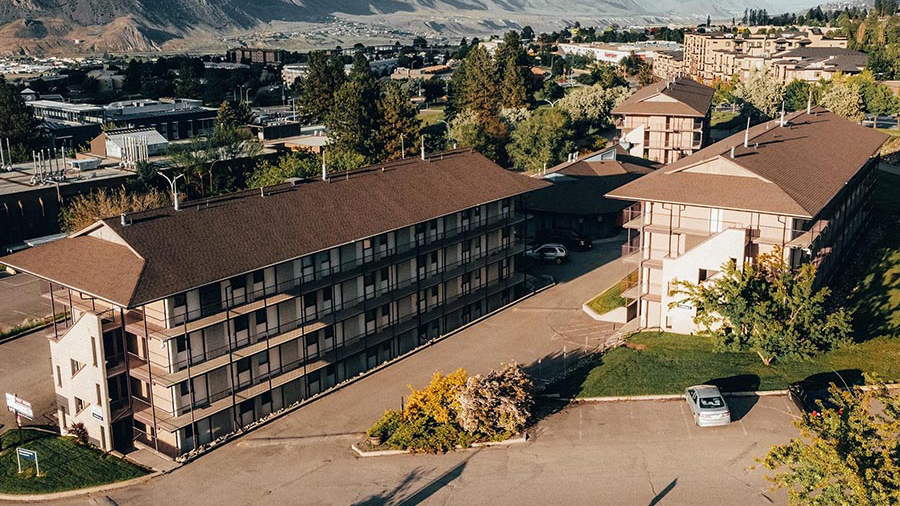This past summer, TRU proposed an application and held a hearing with the Kamloops City Council over rezoning amendments. This rezoning will enable the university, through the TRU Community Trust (TRUCT), to build more mixed-use and residential developments across campus.
This amendment involves revising the boundaries of subzones on campus, which determines land use designations.
Per the application, the area between Summit Drive and University Drive, through which the Guerin Creek gully passes, would be rezoned from a subzone D classification, commonly referred to as an outdoor research area, to a subzone B classification, designated for mixed-use developments. The area north of Hillside Drive and west of Edgehill Place, separated from the rest of campus by the Hillside roadway, will also be adjusted from subzone D to subzone C, a residential precinct.
As neither land is currently being used for research, nor are there any plans to do so, Scott Cramer, public representative for the TRUCT, told the council during the hearing, these proposed amendments will put the virtually dormant lands to good use.
According to the 2024 Kamloops housing needs report, the city needs an additional 23,000 new housing units to meet projected population growth over the next two decades. Cramer described how TRU’s rezoning proposal will contribute positively to the affordable housing crisis in the city by providing more housing units to meet demand. Further, they will also accommodate local businesses, Cramer said, allowing for “more vibrancy on campus.”
Despite these purported benefits, some on campus find the new projects antagonistic to student and community needs and view TRU’s approach to the rezoning efforts as lacking transparency.
For Sophia Ronald, a recent TRU graduate who was present over the summer as the rezoning application signs were posted across campus, these amendments struck her as a cause for serious concern.
“I do not have any issue with building more market housing, nor do I have a problem with TRU making a profit,” she said. “My concerns are related to the sheer quantity of land that TRU has reallocated for market housing while simultaneously not planning to increase student residence beds at all.”
Indeed, student residence has decreased in the past year, following the shutdown of the West Gate dorms, which housed 113 beds and was the most affordable housing option available for students. The university also announced the imminent closure of its second-cheapest residence, McGill, but seems to have temporarily walked back on that, as the residence is still up and running.
How long McGill will stay open is unclear, as TRUCT’s 6-phase masterplan for The Reach, a campus-wide urban community scheme, currently involves the replacement of McGill with even more mixed-use developments.
The total number of beds in student residences is around 1470. Assuming all beds are filled, this means that just under 10 per cent of the entire on-campus population is living in TRU-provided housing. This means roughly 90 per cent of students who attend classes at TRU will be living off-campus in market rental housing units.
Further, the university has no current plans for new residences, citing the drop in international student enrollment as a reason. According to Vice-President, Administration & Finance Matt Milovick, a submission has been made to the Treasury Board to construct another on-campus residence near Coyote Den, although its future remains uncertain.
“I don’t think that’s going to get any traction given what’s happening right now with enrollment,” Milovick said. “We anticipate, at some point in the future, building another 250 beds [at that location] when the time is right, but the time is not now.”
Ronald sees the new development plans, in light of all this, as a sign that the university is failing to sufficiently prioritize students and their housing needs.
“TRU has shown that it is far more interested in lining its pockets through the development of luxury condos on campus than in addressing the very real possibility that students may become homeless due to a lack of residence beds,” Ronald said, as she took the stand in opposition to the amendments during the public hearing on July 15.
Her argument hinged on affordability: living off-campus is expensive, even though, as Cramer insisted, the TRUCT’s planned rental properties “consider affordability metrics,” which involves City and Province-wide standards of “maintaining rent below 30 per cent of income.”
Most employed TRU students work part-time hours, meaning the 30 per cent metric does not quite apply to them. And, unless they are subsidized like on-campus housing, the TRUCT’s ‘affordable rentals’ will certainly be less affordable than residence options.
This issue is even more pressing with international students. Per a recent study, these off-campus rentals take almost 60 per cent of the average monthly earnings of international students, and are riddled with issues from lack of maintenance, random rent increases and discrimination.
TRU and TRUCT, on their part, assure students that housing will be affordable, and the increasingly diverse housing options will not only allow for greater flexibility but also give students a chance to build exciting lives integrated in the wider Kamloops community.
Cramer also brought up recent research conducted by TRUCT, showing that around 45 per cent of residents in their four existing condominiums are in some way “associated with the university.” In his words, this evidences a “pretty significant amount of utilization.”
What “associated with the university” means is uncertain, and does not directly address student concerns unless the percentage of students in these rentals is specified.
Ronald finds this lack of clear and effective communication by the university and the City purposeful, a tactic undertaken to avoid backlash as they proceed with the rezoning and development processes. Signs put up to announce the rezoning application, as well as the email notice of the hearing, were only available to students and community members present in the area at the time. Considering it was the middle of the summer holidays, those numbers were drastically lower than what they would have been any other time of the year.
“TRU has an institution-wide email system that can notify every student and faculty member of their actions in plain language,” Ronald said. “Instead, it was left to the City to send a cryptic email notifying a select few of a public hearing with no explanations or information about the proposed rezoning. Throughout this entire ordeal, I have gotten the sense that both parties are attempting to tell students the least they possibly can. I think it is both unethical and untenable for TRU to continue to disregard student interests in this manner.”

